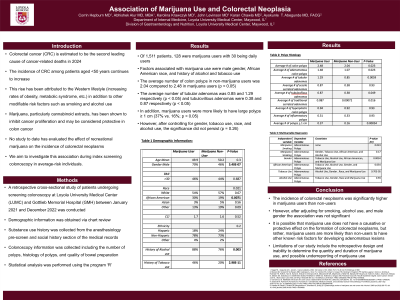Monday Poster Session
Category: Colorectal Cancer Prevention
P2132 - Association of Marijuana Use With Colorectal Neoplasia
Monday, October 28, 2024
10:30 AM - 4:00 PM ET
Location: Exhibit Hall E

Has Audio
- AA
Abhishek A. Alur, MD, MBA
Loyola University Medical Center
Chicago, IL
Presenting Author(s)
Corrin Hepburn1, Abhishek A. Alur, MD, MBA1, Karolina Krawczyk, MD, MS2, John Levinson, MD1, Karan Chawla, MD1, Ayokunle T. Abegunde, MD, MSc, MRCP, FACG3
1Loyola University Medical Center, Chicago, IL; 2Loyola University Medical Center, Harwood Heights, IL; 3Loyola University Medical Center, Maywood, IL
Introduction: Colorectal cancer (CRC) is estimated to be the second leading cause of cancer-related deaths in 2024 and the incidence among patients aged < 50 years continues to increase. This rise has been attributed to Western lifestyle in addition to other modifiable risk factors such as smoking and alcohol use. Marijuana, particularly cannabinoid extracts, has been shown to inhibit cancer proliferation and may be considered protective in colon cancer. However no study has evaluated the effect of recreational marijuana on the incidence of colorectal neoplasms. We aim to investigate this association during index screening colonoscopy in average-risk individuals.
Methods: We conducted a retrospective cross-sectional study of patients undergoing screening colonoscopy at LUMC and GMH between January 2021 and December 2022. Demographic information was obtained via chart review. Substance use history was collected from anesthesiology pre-screen and social history section of the EHR. Colonoscopy information was collected including the number of polyps, histology of polyps, and quality of bowel preparation. Statistical analysis was performed using R.
Results: Of 1,511 patients, 128 patients were marijuana users with 30 daily users. Factors associated with marijuana use were male gender, African American race, and history of alcohol and tobacco use. The average number of colon polyps in non-marijuana users was 2.04 compared to 2.48 in marijuana users (p< 0.05), average number of tubular adenomas was 0.85 and 1.29 respectively (p< 0.05)., and tubulovillous adenomas was 0.38 and 0.87 respectively (p< 0.05). In addition, marijuana users were more likely to have large polyps ≥ 1cm (37% vs. 16%; p< 0.05). However, after controlling for gender, smoking, race, and alcohol use the significance did not persist (p=0.26).
Discussion: The incidence of colorectal neoplasms was significantly higher in marijuana users than non-users. However, after adjusting for smoking, alcohol use, and male gender the association was not significant. Based on our results, it appears that marijuana use does not have a causative or protective effect on the formation of colorectal neoplasms, but rather marijuana users are more likely than non-users to have other known risk factors for developing adenomatous lesions. Limitations of our study include the retrospective design and inability to determine the quantity and duration of marijuana use, and possible underreporting of marijuana use. Therefore, further prospective studies are needed.
Disclosures:
Corrin Hepburn1, Abhishek A. Alur, MD, MBA1, Karolina Krawczyk, MD, MS2, John Levinson, MD1, Karan Chawla, MD1, Ayokunle T. Abegunde, MD, MSc, MRCP, FACG3. P2132 - Association of Marijuana Use With Colorectal Neoplasia, ACG 2024 Annual Scientific Meeting Abstracts. Philadelphia, PA: American College of Gastroenterology.
1Loyola University Medical Center, Chicago, IL; 2Loyola University Medical Center, Harwood Heights, IL; 3Loyola University Medical Center, Maywood, IL
Introduction: Colorectal cancer (CRC) is estimated to be the second leading cause of cancer-related deaths in 2024 and the incidence among patients aged < 50 years continues to increase. This rise has been attributed to Western lifestyle in addition to other modifiable risk factors such as smoking and alcohol use. Marijuana, particularly cannabinoid extracts, has been shown to inhibit cancer proliferation and may be considered protective in colon cancer. However no study has evaluated the effect of recreational marijuana on the incidence of colorectal neoplasms. We aim to investigate this association during index screening colonoscopy in average-risk individuals.
Methods: We conducted a retrospective cross-sectional study of patients undergoing screening colonoscopy at LUMC and GMH between January 2021 and December 2022. Demographic information was obtained via chart review. Substance use history was collected from anesthesiology pre-screen and social history section of the EHR. Colonoscopy information was collected including the number of polyps, histology of polyps, and quality of bowel preparation. Statistical analysis was performed using R.
Results: Of 1,511 patients, 128 patients were marijuana users with 30 daily users. Factors associated with marijuana use were male gender, African American race, and history of alcohol and tobacco use. The average number of colon polyps in non-marijuana users was 2.04 compared to 2.48 in marijuana users (p< 0.05), average number of tubular adenomas was 0.85 and 1.29 respectively (p< 0.05)., and tubulovillous adenomas was 0.38 and 0.87 respectively (p< 0.05). In addition, marijuana users were more likely to have large polyps ≥ 1cm (37% vs. 16%; p< 0.05). However, after controlling for gender, smoking, race, and alcohol use the significance did not persist (p=0.26).
Discussion: The incidence of colorectal neoplasms was significantly higher in marijuana users than non-users. However, after adjusting for smoking, alcohol use, and male gender the association was not significant. Based on our results, it appears that marijuana use does not have a causative or protective effect on the formation of colorectal neoplasms, but rather marijuana users are more likely than non-users to have other known risk factors for developing adenomatous lesions. Limitations of our study include the retrospective design and inability to determine the quantity and duration of marijuana use, and possible underreporting of marijuana use. Therefore, further prospective studies are needed.
Disclosures:
Corrin Hepburn indicated no relevant financial relationships.
Abhishek Alur indicated no relevant financial relationships.
Karolina Krawczyk indicated no relevant financial relationships.
John Levinson indicated no relevant financial relationships.
Karan Chawla indicated no relevant financial relationships.
Ayokunle Abegunde: Ferring Pharmaceuticals – Consultant. Ferring Pharmaceuticals – Consultant.
Corrin Hepburn1, Abhishek A. Alur, MD, MBA1, Karolina Krawczyk, MD, MS2, John Levinson, MD1, Karan Chawla, MD1, Ayokunle T. Abegunde, MD, MSc, MRCP, FACG3. P2132 - Association of Marijuana Use With Colorectal Neoplasia, ACG 2024 Annual Scientific Meeting Abstracts. Philadelphia, PA: American College of Gastroenterology.
